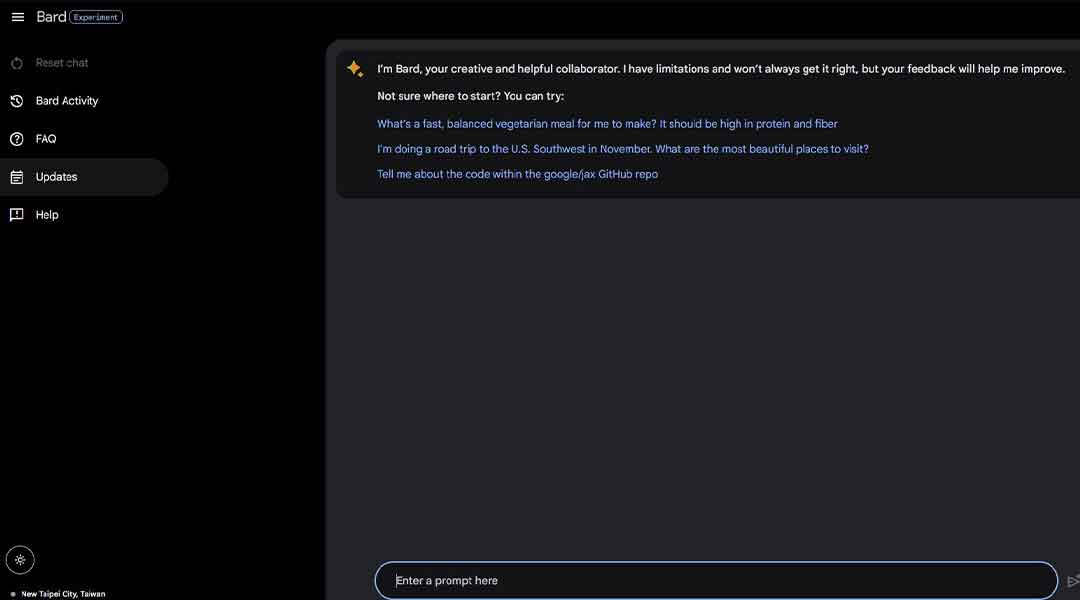Google Bard is an AI-powered search engine designed to make searching easier and more efficient. Google uses natural language processing technology to understand what users are asking for in their queries, then provides them with personalized results tailored to their needs.
To ensure your content is optimized for the best performance on this platform, there are certain techniques that can be used such as incorporating keywords into your copy, writing concise titles and descriptions, etc.
What is Google Bard?
Google Bard, a cutting-edge conversational AI developed by DeepMind, a division of Google dedicated exclusively to AI research, represents both challenges and opportunities for SEO professionals seeking visibility within these new features. Encompassing aspects from Google’s advanced language model LaMDA, it paves the way towards revolutionizing the search experience through rapid data-fetch capabilities leading to timely responses based on current trends.
As a direct competitor to OpenAI’s ChatGPT, Google Bard stands out due to its access to continually updated datasets. Rather than having limited training material that only applies for certain periods until 2021, Google Bard offers flexibility and relevance when the datasets are used efficiently. This optimizes search operations far beyond what is currently possible, transforming common techniques used across many platforms and creating innovative new methods of prominence never before seen.
Benefits of Optimizing for Google Bard
For starters, users will appreciate having a simpler way to understand complex topics and access information more efficiently.
By catering specifically to this AI-based platform, your content can reach new audiences and enjoy greater visibility. Additionally, optimizing for Bard means tapping into an impressive global knowledge repository. This connection helps ensure the accuracy of your material while providing cutting-edge insights that readers value today.
As a result, you’ll be positioning yourself as an industry authority with well-informed perspectives on current events and relevant subjects. Another advantage is making full use of powerful language models like LaMDA, designed to comprehend human speech nuances and decipher multiple languages effectively.
The utilization of optimization efforts targeted towards Google’s advanced conversational AI service provides several tools which can aid in outreach and exploration. Lastly, adapting SEO strategies to focus primarily on enhancing user experience rather than just striving to achieve higher search rankings is beneficial for businesses in the long term. This holistic approach sets up brand loyalty amongst consumers who rely heavily on digital resources such as a company’s internet presence and product offerings that are accessible throughout their daily life.
Setting Up Your Website for Google Bard
Focus on delivering accurate and well-structured content. Since this chatbot relies on LaMDA’s language model that values groundedness in its responses, ensure your site offers verifiable information from credible sources.
Begin by auditing the quality of existing content to identify any inaccuracies or inconsistencies. Make necessary revisions with relevant facts while linking to respected references where appropriate so readers can cross-check details if needed. In addition to accuracy, improve user experience through easy-to-navigate page design and clear headings that logically organize subject matter within each text section.
This structure will benefit human visitors and make it simpler for Bard AI to parse and comprehend data presented on-site quickly. Consistently update webpages as new developments emerge by adding fresh statistics or altering outdated points. Doing so demonstrates a commitment towards providing value-packed resources befitting search engines like Google Bard alongside potential end-users who seek real-time insights into topics rather than recycled rhetoric they might stumble upon elsewhere online.
Draft the Content for Bard
Focus on providing accurate and engaging information. Since Bard learns from vast amounts of data online, ensure that your material is up-to-date and well-researched to stand out. Begin by outlining clear objectives for your piece.
Define what you want to communicate and how it can benefit users interacting with Google’s chatbot technology. Remember that while AI like Bard will analyze your text, real people are still its core target audience. Incorporate relevant keywords throughout the article without overloading or disrupting natural readability.
The seamless integration assists both humans and AI in comprehending each topic discussed efficiently. Additionally, utilize descriptive subheadings as cues to guide readers in exploring various subjects within the content. To demonstrate credibility when presenting facts or opinions from reliable sources, include annotations where applicable.
Displaying transparent attribution fosters trustworthiness among discerning audiences who may scrutinize responses from tools like Bard. Be mindful of varying answers generated during user interactions. Diversify potential outcomes using synonyms coupled with diverse phrasings for essential ideas.
This method eases predictability concerns tied into large language model technologies used extensively today (like OpenAI’s ChatGPT). Last but importantly: always proofread before submission! Your diligence ensures polished delivery devoid of grammar errors which could inadvertently creep through automated systems operated via cutting-edge platforms trending globally nowadays, including Google’s innovative offering aptly dubbed “Bard.”
Design Considerations for Bard
Consider the design elements that contribute towards engaging and informative articles. First, think about readability; ensure font choices are easy on the eyes while maintaining an adequate text size. Additionally, provide ample white space between paragraphs for improved user experience.
Next, prioritize the logical organization of information using descriptive headings and subheadings that guide readers effortlessly through your piece. Bullet points or numbered lists can also be invaluable when concisely presenting important data. Incorporate relevant images or graphics into your article where appropriate to support visual learners and enhance comprehension.
Ensure these visuals possess high resolution, but remain mindful of file sizes to not negatively impact page load times. When incorporating links within your content, either internal navigation aids or references directing users toward external sources, check their validity regularly to avoid broken connections that may harm credibility in both human visitors’ eyes and search engine algorithms.
It is essential to focus on mobile optimization. Nowadays, more than half of the online traffic originates from handheld devices like smartphones and tablets. Therefore, it is critical that all elements of a website adjust to different display dimensions, guaranteeing fluid experiences on every platform. This will lead to work that resonates with the reader regardless of the technology they utilize.
SEO Strategies to Optimize for Bard
Consider the following tips to enhance visibility and search performance. First, ensure your content aligns with Google’s E-E-A-T guidelines: Experience, Expertise, Authoritativeness, and Trustworthiness.
Showcasing the credentials of authors or citing reputable sources can boost credibility. Next, prioritize user experience by designing clear navigation structures within your website. Users should easily locate relevant information on a particular topic based on their queries entered in Google Bard.
Additionally, focus on crafting engaging headlines that succinctly capture users’ attention while addressing their questions accurately since AI-generated answers from Bard will likely compete against featured snippets in SERPs. Another vital aspect is keyword research specific to LaMDA technology. Identify terms associated with popular dialogues or contextual inquiries related to your niche area rather than only targeting traditional short-tail keywords.
This approach supports capturing traffic driven through conversational searches initiated via Google Bard’s interactive interface. Furthermore, analyze data gathered from users interacting with this new feature post-release. Insights regarding frequently asked questions or emerging trends might offer actionable ideas for continually refining content optimization efforts.
Don’t forget about mobile compatibility! Optimize design elements catering towards responsive displays, as more people access search engines via smartphones than desktop computers nowadays.
Submit and Promote Your Articles
Once you’ve optimized your content for Google Bard, the next step involves submitting and promoting your article. To increase visibility and reach a wider audience with this cutting-edge AI technology, consider these steps:
Firstly, submit your well-optimized content to reputable platforms. Target websites or directories focused on providing quality information within your niche.
Secondly, share links to your Bard-enhanced articles relevant to the topic at hand across social media channels. By doing so, you’re more likely to engage readers interested in utilizing advanced search features such as those offered by Google’s chatbot capabilities. Additionally, collaborate with influencers and industry experts aligned with Bard language models’ advancements.
They can provide insights into how best to optimize for this tech-savvy reader base while also increasing awareness about what sets apart Bard-focused pieces from traditional online reading experiences. Lastly, although perhaps most importantly, don’t hesitate when it comes time to evaluate metrics related directly back through user engagement via ongoing updates made using feedback gathered during earlier stages.
Make adjustments based on a strong understanding of the appeal factors to maintain superior ranking positions on different SERP offerings. This includes both broader trending searches done daily and more targeted keywords related specifically to certain areas. This will ensure maximum effectiveness when disseminating messages in today’s highly competitive digital landscape.
Monitor Performance
Monitoring your content’s performance is vital in optimizing its reach and effectiveness. To achieve this, keep track of key metrics that reflect user engagement with your content. One essential tool to utilize is Google Analytics, which offers invaluable insights into various aspects such as page views, average time spent on the page, bounce rate, and exit rates.
By analyzing these metrics carefully over time, you can identify areas where improvements may be necessary for boosting reader interest or retaining their attention throughout the piece. Moreover, evaluate how well users interact with embedded links by monitoring click-through rates (CTRs), particularly if they lead to other relevant articles or resources within your website.
Apart from quantitative data analysis through analytics tools such as Google Analytics, Matomo, or Clicky Web Analyzer, don’t forget to consider qualitative feedback. Gathering reactions and opinions via comments sections under blog posts can give you much more useful insight into what resonates with readers than numbers alone. It can help you understand your audience considerably more effectively.
Finally, yet importantly, don’t neglect SEO factors. It is important to monitor keyword rankings regularly to ensure optimal visibility across major search engines. This will help increase traffic and subsequently improve overall success. The desired outcome can be attained regardless of domain or sector context by maximizing potential returns on investment related to Bard utilization and general measures applied to every aspect of an online presence.
Combining thorough analytical investigation alongside proactive response implementation based on findings is integral to strategies that guarantee continuous development and evolution towards prime outcome-oriented objectives, materializing triumphantly beyond doubt!
Additionally, site owners should pay attention to SEO best practices, such as implementing keyword strategies properly while paying close attention to the quantity and relevance of words used throughout the page or post they’re optimizing.









